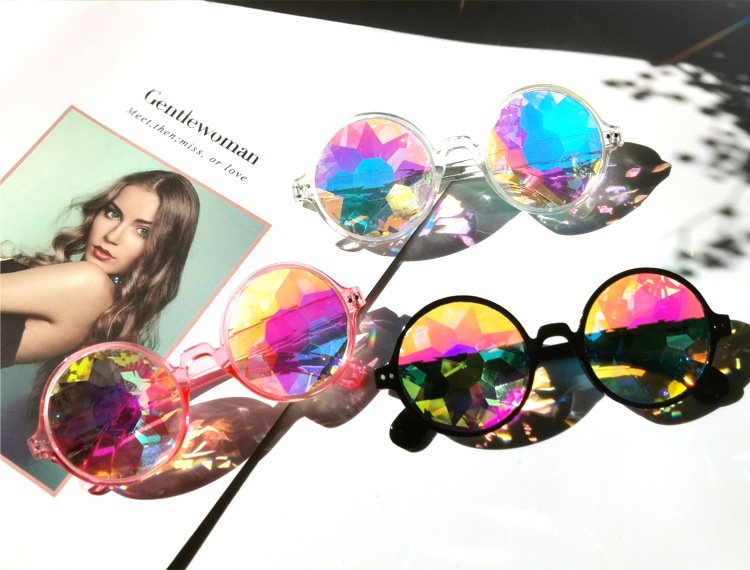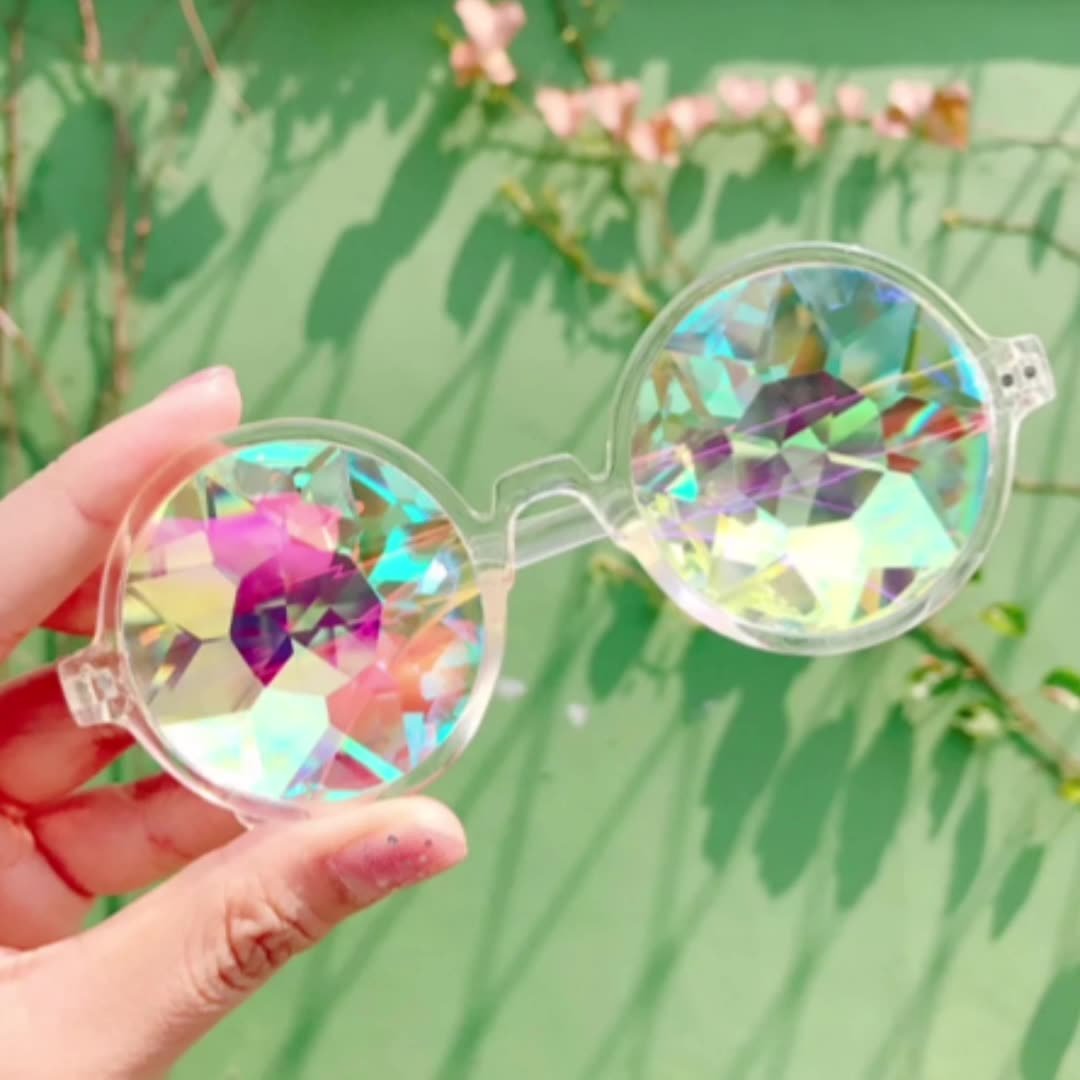In an era where technology and art intersect, kaleidoscope glasses, as an innovative visual tool, are redefining how we perceive the world. This wearable device, which combines traditional optical principles with modern technology, not only offers users an unprecedented visual experience but also demonstrates remarkable potential across multiple fields such as artistic creation, education and entertainment, and mental health. This article will delve into the historical origins, technical principles, diverse applications of kaleidoscope glasses, and how they serve as a bridge connecting technology and art, while also exploring the future visual revolution that this innovative device may lead to.
The origin and evolution of kaleidoscope glasses
The concept of kaleidoscope glasses is rooted in a long history of optical exploration. The traditional kaleidoscope was invented in 1816 by Sir David Brewster, a Scottish scientist, who accidentally created this fascinating optical toy while studying the polarization of light. Early kaleidoscopes consisted of simple mirror arrangements and colored fragments, producing symmetrical and vibrant patterns through light reflection. With advancements in optical technology, artists and inventors in the 20th century began experimenting with applying kaleidoscope principles to wearable devices, with initial attempts including cumbersome designs that attached handheld kaleidoscopes to eyeglass frames.
After entering the 21st century, breakthroughs in materials science and miniaturization technology made true kaleidoscope glasses possible. In recent years, with the integration of augmented reality (AR) technology, modern kaleidoscope glasses have evolved into high-tech products capable of perfectly combining digital and optical effects. Market research data shows that the global market size for creative visual devices reached $3.7 billion in 2022, with the annual growth rate of kaleidoscope glasses products maintaining over 15%, reflecting consumers’ continued enthusiasm for this innovative product.
The design of contemporary kaleidoscope glasses shows a trend towards diversity. From retro-style brass frames paired with prism systems to minimalist smart glasses, different brands have launched distinctive products tailored for niche markets such as artists, educators, and general enthusiasts. Some high-end models even integrate biometric sensors that can automatically adjust visual modes based on the user’s emotional state, achieving a deep integration of technology and humanity.
The technical principles and design of kaleidoscope glasses
The core optical system of a kaleidoscope glasses is based on precise calculations of light reflection principles. Similar to traditional kaleidoscopes, its basic structure includes a triangular prism system formed by three rectangular mirrors arranged at specific angles (usually 60 degrees). When light enters this reflective system, it undergoes multiple reflections, each creating symmetrical replicas of the original image, ultimately forming perfect radial symmetry patterns. The innovation of modern kaleidoscope glasses lies in miniaturizing this system and integrating it into the frame of glasses, while also incorporating adjustable elements that allow users to control the complexity and speed of the patterns.
Material selection is crucial for the performance and user experience of kaleidoscope glasses. The mirror part typically uses ultra-thin glass coated with silver or high-reflection polymers to ensure image clarity and light reflection efficiency. Frame materials have evolved from traditional metals to modern memory titanium alloys and carbon fibers, reducing weight while increasing durability. Optical engineers optimize the curvature and angle arrangement of the mirrors through computer simulations to achieve the best visual effect within the limited space of the glasses. Some cutting-edge designs even incorporate variable geometric structures, allowing users to adjust the mirror angles in real-time using knobs or mobile apps, thus changing the symmetry type and repetition of the patterns.
The multidimensional application value of kaleidoscope glasses
In the fields of art therapy and psychological rehabilitation, kaleidoscope glasses have shown extraordinary value. Clinical studies indicate that immersing oneself in the constantly changing and highly symmetrical visual patterns of a kaleidoscope can effectively reduce anxiety levels and help the brain enter a meditative state. Data from the Boston Art Therapy Center shows that patients with anxiety who used specially designed kaleidoscope glasses experienced an average improvement of 23% in heart rate variability after a 15-minute session, significantly higher than traditional relaxation techniques. For children on the autism spectrum, specific frequencies and complexities of kaleidoscope visual stimuli have been proven to increase attention span and improve sensory integration abilities. After incorporating kaleidoscope glasses into their daily curriculum, teachers at a special education school in New York reported that 68% of students showed stronger classroom engagement and emotional stability.
The field of education also benefits from this innovative tool. In science classes, kaleidoscope glasses become vivid teaching aids for teaching optics, symmetry, and geometric concepts. A physics teacher at a middle school in Minnesota developed a set of experimental courses based on kaleidoscope glasses. where students directly observe pattern changes by adjusting the mirror angles, intuitively understanding the law of reflection of light. Post-class tests showed that the experimental class’s depth of understanding of optical principles was 40% higher than that of traditional teaching classes. In art education, kaleidoscope glasses stimulate students’ creative thinking, and many schools use them as training tools to cultivate pattern design skills and color perception. A survey conducted by the University of the Arts London found that 85% of design majors believe that the experience with kaleidoscope glasses had a positive impact on their creative process.
The adoption of kaleidoscope glasses in the entertainment and creative industries has been particularly rapid. At music festivals and art exhibitions, kaleidoscope glasses have become popular accessories for enhancing audience immersion, working in synergy with light shows and projection mapping technologies to create stunning audiovisual experiences. During the 2022 Coachella Music Festival, the organizers distributed 10,000 specially designed kaleidoscope glasses, generating over 200 million views on social media related topics. In the film and television production sector, kaleidoscope effects are widely used in music videos and sci-fi movies to depict hallucinatory states or otherworldly scenes. Even more excitingly, digital artists are beginning to combine kaleidoscope glasses with VR technology to create interactive immersive art installations. Visitors can not only see changing patterns but also influence the generation process of these patterns through their body movements. This multisensory art form is redefining the boundaries of contemporary art exhibitions.
The cultural significance and social impact of kaleidoscope glasses
The popularity of kaleidoscope glasses reflects the widespread desire in contemporary society for enhanced sensory experiences. In an era of digital information overload, people increasingly seek tools that can temporarily break away from conventional visual patterns and reawaken sensory curiosity. Kaleidoscope glasses meet this need; they are both a form of simple entertainment and a cutting-edge sensory enhancement technology. Sociologists have observed that the user base for kaleidoscope glasses exhibits clear cross-age and cross-cultural characteristics, resonating with individuals from children to the elderly, and from East to West. A cultural study by the University of Tokyo revealed that among urban populations with high stress levels, kaleidoscope glasses are seen as a ‘digital detox’ tool. helping users switch from linear screen-based visual modes to non-linear, meditative viewing experiences.
This innovative device is also changing how people engage with visual art. In traditional art appreciation, viewers usually find themselves in a passive receiving position; however, kaleidoscope glasses transform each user into an active creator, generating unique visual patterns through simple head movements. This shift has given rise to a new form of art—’participatory visual art’—where the final form of the artwork depends on the viewer’s interaction.
The function of a kaleidoscope glasses
The function of a kaleidoscope glasses is to create ever-changing patterns of colors and shapes by reflecting light through mirrors inside the device, providing a visually stimulating experience.But we didn’t stop there. For years, kaleidoscope glasses were limited to perfect round lenses and frames. Therefore, we created a lens that works with our best casing—the PC frame. Now, users can see a wider range of rich prism colors with the most popular frame styles. We designed the ultimate kaleidoscope glasses for any fractal eyewear enthusiast. Each pair of ultimate kaleidoscope glasses is crafted with exceptional craftsmanship.
For every festival, party, or cosplay event, put on these dazzling kaleidoscope party glasses and stand out! These prism lenses are intricately designed to beautifully refract light, creating stunning visual effects that enhance your party or festive experience.
Made from high-quality, durable materials, these lightweight and comfortable sunglasses are perfect for all-day wear. The round frame design adds a touch of fashionable retro, making them ideal accessories for music festivals, electronic dance events, cosplay, and creative photography! Want to catch eyes and elevate your look? Whether at parties, on stage, or when showcasing your unique style, these mosaic prism glasses are the ultimate fashion statement. Plus, they offer an extra layer of sun protection, making them both stylish and practical!
Don’t miss out—buy your kaleidoscope party glasses today and add bold, vibrant style to your next event! Get ready for the holiday season with these adorable kaleidoscope sunglasses, offering the ultimate festive look!

Future outlook and innovation direction
Kaleidoscope glasses technology is evolving towards more intelligent, personalized, and interactive directions. Breakthroughs in materials science will bring lighter and optically superior mirror materials, such as nanostructured reflective arrays based on metasurfaces, which can achieve programmable reflection properties on a single lens. The deep integration of augmented reality technology will enable future kaleidoscope glasses to seamlessly incorporate digitally generated elements into the optical patterns, allowing users to adjust visual effects in real-time via gestures or voice commands. The inclusion of artificial intelligence algorithms will allow the device to learn users’ aesthetic preferences and automatically generate visual patterns that best match their personal tastes. Industry analysts predict that by 2028, the market for smart kaleidoscope glasses will reach $8.2 billion, with a compound annual growth rate of around 18%.
Sustainability and accessibility are key considerations for future development. Leading brands are currently exploring the use of recycled materials and modular designs to reduce their environmental footprint, with some experimental products even using biodegradable frameworks and replaceable optical components. To expand their user base, designers are dedicated to developing more affordable basic models while encouraging user communities to share custom visual patterns and DIY improvement plans through open-source platforms. This open-innovation model is expected to accelerate the democratization of kaleidoscope glasses technology, transforming it from a niche tool for professional artists and early adopters into a mass-market creative medium and health aid.
Kaleidoscope glasses represent a modern embodiment of humanity’s eternal pursuit—to see the world in new ways. From simple optical toys of the 19th century to high-tech wearable devices of the 21st century, the continuous evolution of kaleidoscope principles demonstrates how fundamental scientific concepts can be rejuvenated through technological innovation. This seemingly simple device continues to captivate human imagination across cultural and technological boundaries because it touches on basic questions about perception, creativity, and consciousness itself. In an era where virtual reality and artificial intelligence are reshaping human experiences, kaleidoscope glasses remind us that sometimes the most transformative technologies are not those that aim to completely replace reality but rather those that gently alter our relationship with it. Looking ahead, as optics, materials, and digital technologies further converge, kaleidoscope glasses will continue to expand their multifaceted identities as an artistic medium, therapeutic tool, and platform for perceptual exploration, offering humanity a constantly changing window through which we can both glimpse the infinite possibilities of the external world and catch a glimpse of the profound landscapes within ourselves.


